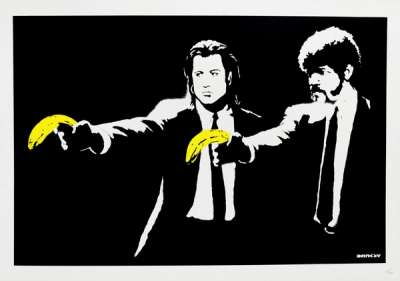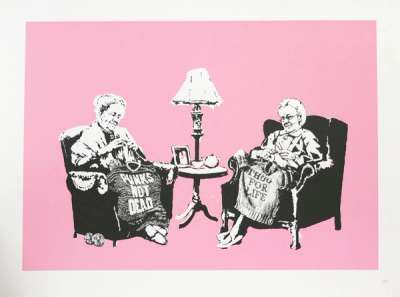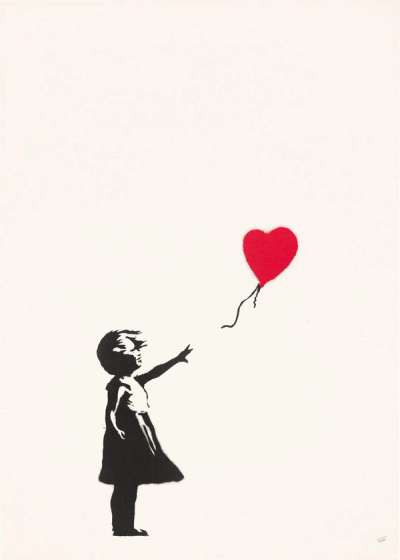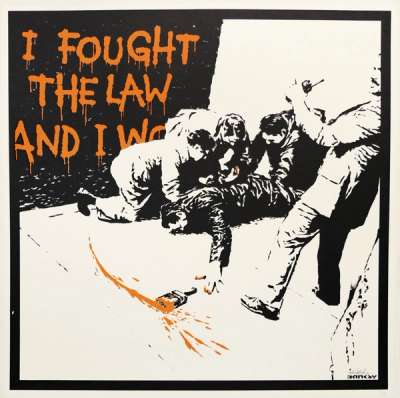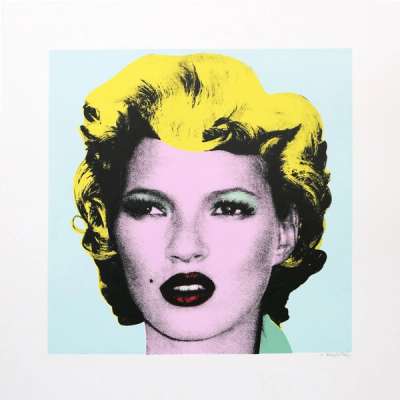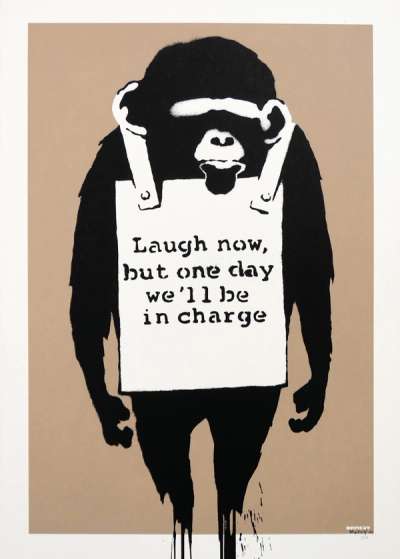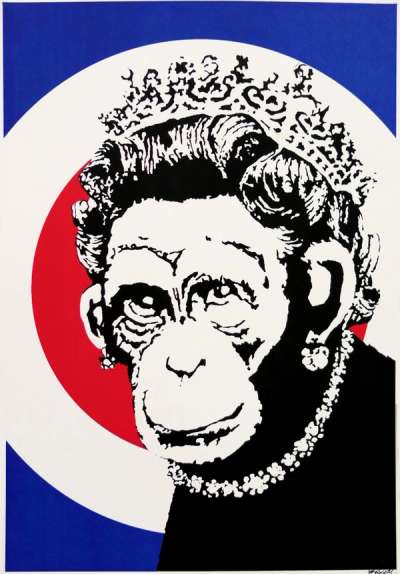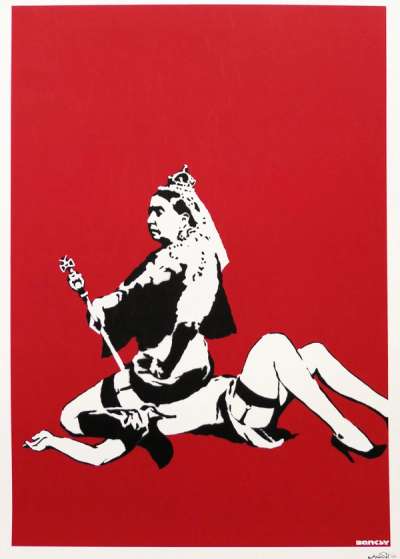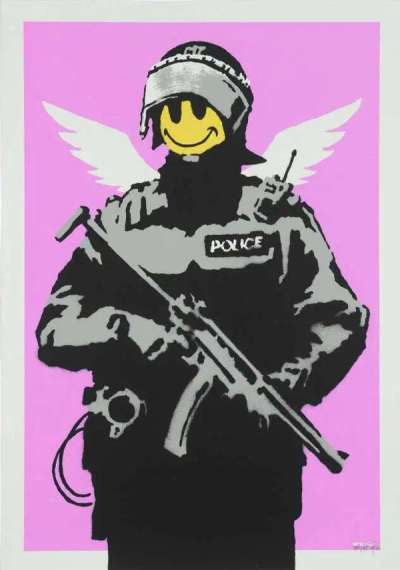Banksy's Abe Lincoln

 Abe Lincoln © Banksy 2008
Abe Lincoln © Banksy 2008 
Banksy
269 works
With an irreverent glint and a touch of the macabre, Banksy’s Abe Lincoln, is a spray paint work from 2008 that plays with the dignified image of the 16th President of the United States, Abraham Lincoln. This unsigned piece, stencilled onto cardboard, features the former president with exaggerated, cartoonish white eyes that seem to weep over the cardboard canvas, a repeating wallpaper-like pattern adding texture to the background. The artwork, marked with Banksy's iconic peace sign and a heart, stands as a symbol of juxtaposition: a reverent figure depicted with an irreverent twist, the highbrow and the lowbrow clashing on a single plane.
Abe Lincoln Meaning & Anaysis
At first glance, Banksy's Abe Lincoln demands attention with its haunting qualities: the cartoonish white eyes that seem to bleed in their sockets. This jarring element on a stencilled image of such a dignified historical figure is classic Banksy – humour and horror coexisting in a single frame. These exaggerated eyes are not just a playful touch but a pointed commentary. They represent Lincoln's shock and dismay at the contemporary socio-political landscape, particularly the aftermath of Hurricane Katrina in New Orleans and the government's inadequate response.
The cardboard base of the artwork adds another layer to its interpretation. It symbolises the ephemeral and discarded, contrasting sharply with the grandeur and permanence associated with historical portraiture and traditional art mediums. Banksy's choice of cardboard as a canvas is a metaphor for the transient and neglected state of the victims post-Katrina, juxtaposed against the historical weight of Lincoln's legacy as the Great Emancipator.
Banksy's use of a repeating wallpaper-like pattern in the background further enhances the sense of domesticity, bringing the lofty image of Lincoln into a more commonplace, almost banal realm. This inclusion speaks to Banksy's ability to bridge the gap between high art and everyday experiences, making a powerful statement on the accessibility of art and the omnipresence of political narratives.
In this piece, Banksy's Lincoln is an observer to the years of unrectified injustice that followed one of the most devastating natural disasters in American history. The peace sign, the initial 'B' within a circle, and the small heart signed in the corner, however, offer a sliver of hope amidst the critique – a reminder of the artist's underlying belief in peace, love, and perhaps, a call to social responsibility.
Banksy's critique is multifaceted, extending beyond the content of the artwork to its very presentation. The juxtaposition of a grand gold frame against the rudimentary cardboard canvas is a visual pun on the disparities of wealth and poverty, power and helplessness. It also touches upon the deeper irony of how historical figures are revered, how their legacies are commodified, yet their foundational values are often overlooked in the face of contemporary challenges.
Abe Lincoln is as much a piece of art as it is a historical document of Banksy's social commentary. The irony is not lost that an artwork depicting a former president known for his progressive policies is used to highlight the failure of progress in modern times. Banksy's work remains a testament to the power of visual art as a means to challenge the viewer, question societal norms, and provoke thought on the contradictions that define our times.
“This work layers historical reverence with modern irreverence, using exaggerated features to comment on contemporary socio-political issues in the United States.”

Banksy's Abe Lincoln and the Modern Art Landscape
Banksy’s Abe Lincoln invites contemplation on the dissonance between historical ideals and contemporary realities. The artwork's interplay of materials like spray paint on cardboard echoes the fragility of societal progress, particularly in the face of natural disasters and their aftermath. Lincoln's altered image serves as a stark reminder that the values he championed are yet to be fully realised.
Banksy's Abe Lincoln emerges as a canvas rife with contradictions that hold a mirror up to society's own paradoxes. This artwork, an interplay of shadow and substance, serves not merely as a visual spectacle but as a barometer of cultural introspection. The use of spray paint, a medium often associated with the transitory, on cardboard, an emblem of the disposable, constructs a narrative of neglect akin to the socio-political negligence observed in the wake of Katrina's devastation.
Within the artwork's frame, Banksy orchestrates a confluence of high and low culture, a juxtaposition that offers an incisive comment on class and worth. The insertion of cartoon eyes into the solemnity of Lincoln's portrait is not only an irreverent act, but a disruption of the viewer's expectations, compelling an engagement with the overlooked narratives of inequality and neglect.
The artist's selection of Lincoln as a subject – once a symbol of unity and liberation – is recontextualised to expose the faults in a nation's facade of progress. In the context of Banksy's broader work, Abe Lincoln shines as an example of the artist's commitment to social critique through art. It’s as a testament to the enduring power of visual expression in questioning and challenging the status quo, urging viewers to reflect on the past's echoes in the present and the ongoing quest for a more equitable society.
